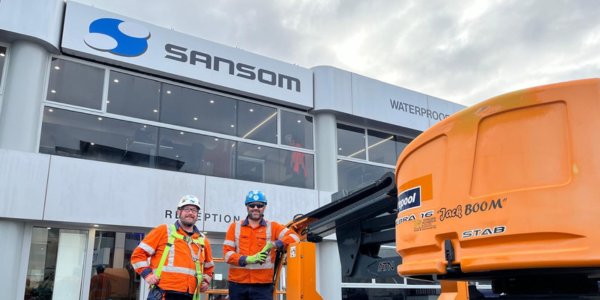What is a roof defined as exactly?
Besides being the obvious structure that sits on top of a building, a roof can include the top of buildings, decks, podiums, gardens, garden boxes, car park roofs, and exterior walkways, which have building space below them.
Other than its primary function, it can also be a vulnerable point in a structure if handled incorrectly.
As a general rule, 80% of a building’s issues are water ingress as a result of issues around waterproofing of the roof alone. Strangely, this waterproofing only accounts for around 2% of the total cost of a new building.
Water ingress can occur through various pathways. Apart from roof leaks or damaged or improperly installed roofing materials, it can occur from inadequate flashing or sealing around penetrations, deteriorated or missing roof components, poor drainage systems, and other structural vulnerabilities.
With this in mind, it is crucial that the installation of the membrane at the construction stage is carried out correctly and then thoroughly tested and checked for possible leaks or damage during and after installation.
Who’s liable?
When the substrate is completed, it’s time for the membrane to be installed. Once the applicator has completed the installation and checked it thoroughly, a final QA test with electric field vector mapping (EFVM) or flood testing is conducted. This EFVM testing process is a crucial step before the membrane is covered to detect any mechanical damage or identify points where water could come in. The tests are conducted by ILD New Zealand, in line with regulations from the council, the supplier’s requirements, and the building code.
Like a warrant of fitness for the membrane, a report will detail any issues, remedial work done and satisfactory sign-off. With no further work to be done by the membrane applicator, their warranty will commence as a verified installation. Construction of the rest of the roof can resume, and the main contractor and the council will assume the protection liability from this point on.
There can of course be some grey areas around liability. Once a building has been fully constructed and water tightness issues are identified, it can be very difficult to prove who is at fault. Additional EFVM tests are possible to pinpoint breaches but not attribute blame or fault.
Ongoing work by trades
It can be extremely easy to damage or compromise the membrane once it has been completed if not protected properly, and with numerous other trades following behind, this can be a big risk.
Sometimes other trades may not fully realise the impact of minor damage to the membrane, or might not realise it has been compromised. Even small incidents such as dropping a hammer can lead to complex remedial work in the future if damage is not identified and fixed straight away.
Temporary protection is routinely used to mitigate any potential damage, which may be caused by trades installing cladding, flashings, handrails, etc.
Waterproofing your roofs is not where you should cut costs
As mentioned, the majority of water ingress issues can be attributed to the incorrect installation or damage to the waterproofing membrane.
There are instances of projects where costs have been saved in this area, however, it is not advisable to take shortcuts here. Bearing in mind that once a building has been completed, it can prove complicated and costly to fix or manage ongoing water tightness issues. So, it is imperative the job is done correctly during construction, and that costs are not scrimped in this area.
Sansom is committed to getting involved in the design phase and talking to the main contractors about the buildability and the durability of the membrane during construction, to help alleviate potential issues with the integrity of the membrane.
Protecting the roof from the weather as its built
During construction, roofs, particularly ‘warm roofs’ which are in line with better insulation requirements for new buildings, can become susceptible to water ingress. Until the membrane is installed, and without adequate protection, it can be exposed to the elements. Without weather protection, the warm roof construction team has to try and avoid rain wherever possible, and work needs to be closed up every day.
For example, an Auckland project had a shrink wrap structure in place, but unfortunately it was leaking in bad weather conditions. Moisture became trapped in between the substrate and the membrane and wasn’t dried out during the installation process. A year later, this caused problems with expansion and contraction in different temperatures, and ultimately water damage to insulation boards. The building owner is now pursuing litigation options to resolve this complex expensive repair.
This stands as an example of how the environment can be compromised and subsequent issues can exist, only to be discovered long after the completion of the build.
Weather protection is a critical part of the construction process. There will be more costs involved, however as we have seen dramatic changes in weather and extreme events this year, developers and contractors should be allowing for the provision and associated costs of shrink wrap structures to help mitigate potential damage or loss. Avoiding water damage in the initial stages could save big headaches in the future.
Experience
Waterproofing a roof is simply not an area where costs should be cut, or one where corners can be cut during the roof construction process. Shortcuts in this area can lead to costly remedial work down the track, ongoing water tightness management, or in some cases, a complete roof replacement.
At Sansom, our breadth of experience sets us apart. As a business that was founded in the 1970s, there isn’t much we haven’t seen in terms of waterproofing projects.
With one of the most comprehensive quality assurance processes in the industry, we are confident that any application will be completed to the highest standards of compliance and workmanship.
With this knowledge and experience passed down through the generations, every team member shares in this strong commitment to high work standards and doing things right the first time.
Find out more about how Sansom can help. Get in touch to start a conversation: sansom.co.nz/contact-us/




